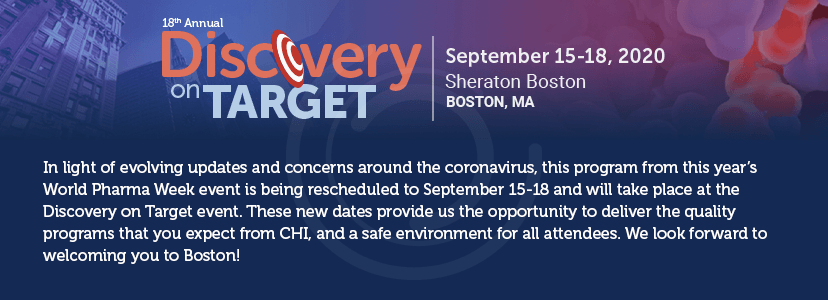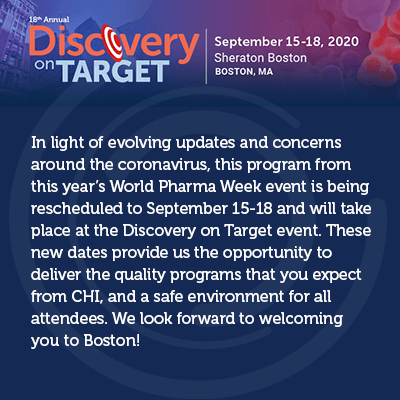

Cambridge Healthtech Institute’s Inaugural
Emerging Indications and Modalities
Progress in CNS and Rare Diseases, Gene and Cell Therapy, Fibrosis and Liver Diseases
June 2-4, 2020
Significant progress in the fields of genetics, protein science, and drug discovery is driving a renewed interest in emerging indications outside of oncology, and important indications, such as CNS, rare diseases, fibrosis and liver disease. Moreover,
new and exciting technologies, such as cell, gene, and gene-edited therapies are offering a new way of treating previously untreatable diseases, and are quickly advancing through the clinic.
CHI's Emerging Indications and Modalities conference provides a platform for pharma, biotech, and academia to discuss and benchmark the latest advances in developing new drug targets and novel therapies across the fields of neuroscience,
rare diseases, fibrosis and liver diseases, as well as the unique challenges facing cell and gene therapy development. How do your drug discovery and translational strategies compare?
Final Agenda
Day 1 | Day 2 | Day 3 | Download Brochure
SC4: Optimizing Drug Metabolism, Drug Clearance and Drug-Drug Interactions - Detailed Agenda
*Separate registration required.
Tuesday, June 210:00 am Main Conference Registration OpeN
A greater understanding of CNS-related disease biology and the emergence of new, improved targets and technologies are advancing the development of neurological therapeutics. This session focuses on the latest strategies, modalities and translational
challenges driving CNS drug development.
11:15 Chairperson’s Remarks
Dario Doller, PhD, Director, Medicinal Chemistry, Sunovion Pharmaceuticals
11:25 Matching the Right Modality to the Right Mechanism for the Right Patient
Julie Chen, PhD, Chemical and Structural Biology Lead, Eisai Center for Genetics Guided Dementia Discovery (G2D2)
11:55 Small Molecule Treatment of Brain Diseases: A Perspective on the Path Forward, Looking Up from the Bottom
 Dario
Doller, PhD, Director, Medicinal Chemistry, Sunovion Pharmaceuticals
Dario
Doller, PhD, Director, Medicinal Chemistry, Sunovion Pharmaceuticals
This presentation will analyze and discuss the key challenges facing CNS drug discovery and development, including: where we have been, contemporary neuroscience pipelines, success in CNS drug research, context, contrast and expectations, and where
to now?
12:25 pm Leveraging the Power of Human Genetics to Go beyond A-Beta and Tau
Tiernan O'Mally, PhD, Associate Director, Translational Human Biology, Eisai Center for Genetics Guided Dementia Discovery (G2D2)
12:55 Transition to Lunch
1:00 Luncheon Presentation (Sponsorship Opportunity Available) or Enjoy Lunch on Your Own
1:30 Session Break
2:00 Chairperson’s Remarks
Dario Doller, PhD, Director, Medicinal Chemistry, Sunovion Pharmaceuticals
2:05 Machine Learning Models in CNS Drug Discovery and Penetrating the BBB
 Istvan Enyedy, PhD, Director, Black Diamond Therapeutics
Istvan Enyedy, PhD, Director, Black Diamond Therapeutics
The design of therapeutic agents that penetrate the blood-brain barrier is challenging mainly due to the promiscuity of efflux transporters. The structures of P-gp and BCRP have been published allowing us to build machine learning models that combine
the transporter structural information with traditional ligand-based descriptors. The performance of these models will be presented.
2:35 PET Imaging of Neuroinflammation in Neurodegenerative Diseases
 Changning
Wang, PhD, Assistant Professor of Radiology, Athinoula A. Martinos Center for Biomedical Imaging, Massachusetts General Hospital, Harvard Medical School
Changning
Wang, PhD, Assistant Professor of Radiology, Athinoula A. Martinos Center for Biomedical Imaging, Massachusetts General Hospital, Harvard Medical School
Molecular imaging, such as PET, has been widely used in medical research and drug discovery. We have developed new imaging tools and applied them in clinical research and drug discovery. In this presentation, I will discuss the development and application
of molecular neuroimaging techniques for brain research. Our work is a unique example on the multidisciplinary research, including molecular imaging, medicinal chemistry, clinical research and preclinical drug discovery.
3:05 A Neuroinflammatory Translational Pipeline for Neurodegenerative Diseases
 Jonathan Levenson, PhD, Vice President, Translational Biology, Tiaki Therapeutics
Jonathan Levenson, PhD, Vice President, Translational Biology, Tiaki Therapeutics
Neuroinflammation is a pathological hallmark of CNS degenerative diseases, yet preclinical translational tools to support drug discovery programs are lacking. Tiaki has developed an ex vivo slice culture and an animal
model that manifests a neuroinflammatory state that is aligned with Alzheimer’s and Huntington’s disease. Using these tools, a novel anti-inflammatory target for neurodegenerative disease, which was identified using curated human data,
has been progressed to lead optimization.
3:35 Sponsored Presentation (Opportunity Available)
4:05 Networking Refreshment Break and Transition to Keynote
4:25 - 6:05
Driving Entrepreneurial Innovation to Accelerate Therapeutic Discoveries
The life sciences community has an unprecedented scientific arsenal to discovery, develop and implement treatments, cures and preventions that enhance human healthcare.
Moderator: Nadeem Sarwar, President, Eisai Center for Genetics Guided Dementia Discovery (G2D2), Eisai Inc.
Panelists: Anthony Philippakis, Chief Data Officer, Broad Institute; Venture Partner, GV
Barbara Sosnowski, Vice President and Global Head, Emerging Science & Innovation Leads, WWRDM, Pfizer
John Hallinan, Chief Business Officer, Massachusetts Biotechnology Council
6:05 Welcome Reception in the Exhibit Hall with Poster Viewing
7:10 Close of Day
Day 1 | Day 2 | Day 3 | Download Brochure
Wednesday, June 3
This session provides a platform for pharma, biotech, and academia to discuss and benchmark the latest advances in developing new drug targets and novel therapies across the fields of neuroscience, rare diseases, and gene and cell therapy. How do
your drug discovery and translational strategies compare?
7:30 am Registration Open and Morning Coffee
8:10 Chairperson’s Remarks
Dario Doller, PhD, Director, Medicinal Chemistry, Sunovion Pharmaceuticals
8:15 Gene Therapy Development for Neurological Diseases
 Gabriele Proetzel, PhD, Director, External Neuroscience Innovation, Neuroscience Drug Discovery Unit, Takeda Pharmaceuticals
Gabriele Proetzel, PhD, Director, External Neuroscience Innovation, Neuroscience Drug Discovery Unit, Takeda Pharmaceuticals
With the approval of Zolgensma, gene therapy for neurological disorders have become a reality. This presentation will discuss the recent advances for in vivo gene therapy development for the neuronal diseases with
their challenges and opportunities. The focus will be on adeno-associated virus (AAV), key aspects for preclinical development and how this is different from classical drug discovery. Discussed will be payload options, delivery, and preclinical
models critical for advancing gene therapy into the clinic and to the patient.
8:45 Preclinical Development of an Intrathecally-Administered ASO to Treat Spinal Muscular Atrophy
 Kenneth
S. Loveday, PhD, DABT, Principal Investigator, Preclinical Safety, Biogen
Kenneth
S. Loveday, PhD, DABT, Principal Investigator, Preclinical Safety, Biogen
Patients with spinal muscular atrophy have a defect in the SMN1 gene. Nusinersen is an ASO designed to increase production of SMN protein from the SMN2 gene by modifying splicing of pre-mRNA. Toxicology studies in monkeys used intrathecal dosing to
deliver nusinersen across the blood-brain barrier into CSF to its site of action: spinal cord motor neurons. The clinical development program was successful, and initial regulatory approval occurred in December of 2016.
9:15 Tissue Distribution and PK of Antisense Oligonucleotides following Intrathecal Administration
 Natasha Penner, PhD, Director, Clinical Pharmacology and Pharmacometrics, Biogen
Natasha Penner, PhD, Director, Clinical Pharmacology and Pharmacometrics, Biogen
With oligonucleotides unable to penetrate the blood-brain barrier, this presentation describes tissue distribution and PK of antisense oligonucleotides following intrathecal administration. Nusinersen is an ASO designed to increase production of SMN
protein from the SMN2 gene by modifying splicing of pre-mRNA. The clinical development program was successful, and initial regulatory approval occurred in December of 2016.
9:45 Sponsored Presentation (Opportunity Available)
10:00 Sponsored Presentation (Opportunity Available)
10:15 Coffee Break in the Exhibit Hall with Poster Viewing
11:00 Lysosomal Dysfunction in Common Neurodegenerative Diseases: From Genetics to the Clinic
 Pablo
Sardi, PhD, R&D Senior Director, Rare and Neurological Diseases, Sanofi
Pablo
Sardi, PhD, R&D Senior Director, Rare and Neurological Diseases, Sanofi
This presentation will discuss: clinical, genetic and experimental evidence underlies the relevance of lysosomal dysfunction in Parkinson’s disease (PD), and mutations in the lysosomal glucocerebrosidase gene (GBA) accelerate PD progression.
First trial has begun testing a GBA pathway modulator in a genetically defined population, and modulation of the lysosomal pathway may also benefit a larger sporadic patient population.
11:30 Targeting Ataxin-2 against TDP43 Pathology Associated with Amyotrophic Lateral Sclerosis and Frontotemporal Dementia
 Yinghui Hu, PhD, Associate Principal Scientist, Neurodegeneration Group, Merck
Yinghui Hu, PhD, Associate Principal Scientist, Neurodegeneration Group, Merck
Ataxin-2 has been identified as a potent modifier of TDP43-toxicity. We demonstrated that knockdown of Ataxin-2 or inhibition of Ataxin-2 interaction with TDP43 effectively reversed TDP43-induced toxicity in hu-iPSC neurons. Proteomic analysis was
also performed to identify a specific set of proteins associated with the aberrant Ataxin-2/TDP43 interaction. These findings led us to explore various approaches and modalities that can be used as novel strategy for therapeutic intervention.
12:00 pm Sponsored Presentation (Opportunity Available)
12:30 Transition to Lunch
12:35 Luncheon Presentation (Sponsorship Opportunity Available) or Enjoy Lunch on Your Own
1:05 Session Break
1:45 - 3:15
Lgr5 Stem Cell-Based Organoids in Human Disease
 Hans Clevers,
MD, PhD, Principal Investigator of Hubrecht Institute and Princess Máxima Center, CSO of HUB Organoids Technology
Hans Clevers,
MD, PhD, Principal Investigator of Hubrecht Institute and Princess Máxima Center, CSO of HUB Organoids Technology
Organoid technology opens a range of applications in fields such as physiology, study of disease, drug development and personalized medicine. Human organoids represent excellent disease models, be it infectious, hereditary or malignant Eventually,
cultured mini-organs may be used to replace transplant organs from donors. I will describe how we originally created ‘mini-guts’ via 3D culture systems of stem cells of the small intestine and colon, and then expanded the technology
to virtually all human organs.
Systematically Drugging Ras
 Stephen Fesik,
PhD, Professor of Biochemistry, Pharmacology, and Chemistry, Orrin H. Ingram II Chair in Cancer Research, Vanderbilt University School of Medicine
Stephen Fesik,
PhD, Professor of Biochemistry, Pharmacology, and Chemistry, Orrin H. Ingram II Chair in Cancer Research, Vanderbilt University School of Medicine
K-Ras is a small GTPase that is mutated in pancreatic (90%), colon (50%), and lung (30%) carcinomas. Downregulation of activated Ras reverses the transformed phenotype of cells and results in the dramatic regression of tumors in murine xenograft
models. Thus, K-Ras inhibition represents an attractive therapeutic strategy for many cancers. In this presentation, I will discuss our efforts to directly target Ras at two sites and target SOS, a molecular partner of Ras, with activators
and inhibitors.
3:15 Refreshment Break in the Exhibit Hall with Poster Viewing
4:00 Chairperson’s Remarks
Dario Doller, PhD, Director, Medicinal Chemistry, Sunovion Pharmaceuticals
4:05 Authentic Cell Therapies for Intractable Neurological Diseases
 Stefan Irion, MD, Vice President, Translational Neuroscience, BlueRock Therapeutics
Stefan Irion, MD, Vice President, Translational Neuroscience, BlueRock Therapeutics
The convergence of cell biology and genetic engineering is creating fundamental new ways to impact disease. Founded in 2016 to capitalize on these technological breakthroughs, we are advancing our novel platform to develop, manufacture, and deliver
an entirely new generation of authentic and engineered cell therapies across three therapeutic areas: neurology, cardiology, and immunology. This presentation will focus on cell therapies for intractable neurological diseases.
4:35 Disruption of RNA Metabolism in Neurological Diseases and Emerging Therapeutic Interventions
 Matthew
Nolan, PhD, Post Doc Research Fellow, Harvard Medical School and Massachusetts General Hospital
Matthew
Nolan, PhD, Post Doc Research Fellow, Harvard Medical School and Massachusetts General Hospital
RNA binding proteins are critical to the maintenance of the transcriptome via controlled regulation of RNA processing and transport. Alterations of these proteins impact multiple steps of the RNA life cycle resulting in various molecular phenotypes
such as aberrant RNA splicing, transport, and stability. Emerging therapeutic approaches to mitigate or reverse alterations of RNA binding proteins in neurological diseases are discussed.
5:05 Find Your Table, Meet Your Moderator
5:10 Roundtable Breakout Discussions - View Details
TABLE: Translational Strategies in CNS Drug Development
Moderator: Dario Doller, PhD, Director, Medicinal Chemistry, Sunovion Pharmaceuticals
TABLE: AI and Machine Learning in CNS Drug Development
Moderator: Istvan Enyedy, PhD, Principal Scientist, Medicinal Chemistry, Biogen
TABLE: Modeling Fibrosis
Moderator: Vanessa Morales-Tirado, PhD, Principal Research Scientist, Translational Immunology, Immunology Discovery, AbbVie Bioresearch Center
5:45 Reception in the Exhibit Hall with Poster Viewing
6:45 Close of Day
Day 1 | Day 2 | Day 3 | Download Brochure
Thursday, June 4
Finding new medical treatments for fibrosis, especially of the lung and liver, is a growing area of activity in the drug development industry. Not only are the incidences of fibrotic or different types of liver disease rising as our population
ages, but new scientic evidence is revealing points of therapeutic intervention. On the last day of this conference, join us to explore the translational challenges and hear about new dug targets in these areas of fibrosis and liver diseases.
8:00 am Registration Open and Morning Coffee
8:30 - 9:40 Applications of Artificial Intelligence in Drug Discovery – Separating Hype from Utility
Patrick Walters, PhD, Senior Vice President, Computation, Relay Therapeutics
Over the last few years, there has been tremendous interest in the application of artificial intelligence and machine learning in drug discovery. Ultimately, the success of any predictive model comes down to three factors: data, representation,
and algorithms. This presentation will provide an overview of these factors and how they are critical to the successful implementation and deployment of AI methods.
9:40 Coffee Break in the Exhibit Hall with Poster Viewing
10:25 Chairperson’s Remarks
10:30 Fibrosis Biomarker Tool Kit for the Lung and Beyond
 Vanessa Morales-Tirado, PhD, Principal Research Scientist, Translational Immunology, Immunology Discovery, AbbVie Bioresearch Center
Vanessa Morales-Tirado, PhD, Principal Research Scientist, Translational Immunology, Immunology Discovery, AbbVie Bioresearch Center
Efficient, novel therapeutics against fibrotic diseases are highly desirable. Identification of biomarkers contribute to understanding of disease mechanisms, acceleration of drug development and clinical management. Accessibility to tissues
and disease target activities is a challenge in fibrotic diseases such as IPF and scleroderma, highlighting the need for the identification of non-invasive biomarkers to represent drug pharmacodynamics and disease biology. Here, we present
novel tools to identify biomarkers in fibrotic diseases.
11:00 Role of Fibroblast Expression of Integrin-Alpha V in Fibrosis and InflammatioN
 Kevin
Hart, PhD, Principal Scientist, Inflammation, Pfizer Inc.
Kevin
Hart, PhD, Principal Scientist, Inflammation, Pfizer Inc.
Since some integrins can serve as master regulators of fibrosis, we investigated if integrin-alpha V is critical during polarized inflammatory responses during tissue damage disease models. While data confirmed a role for integrin-alpha V
in type 17-associated fibrosis, integrin-alpha V was not critical to the development of type 2-driven fibrosis. However, our studies reveal a novel mechanism through which fibroblasts, via integrin-alpha V expression, are capable of regulating
immune polarization.
11:30 Targeting Integrins for Fibrosis
 Scott Turner, PhD, Vice President, Translational Sciences, Pliant Therapeutics
Scott Turner, PhD, Vice President, Translational Sciences, Pliant Therapeutics
aV integrins are a subset of a family of heterodimeric transmembrane proteins that mediate cell-cell and cell-extracellular matrix signaling. Targeting aV integrins with small molecules has been a challenge in the drug discovery field, primarily
due to limited approaches to selectivity, complex signaling mechanisms, poor ADME properties and poor translation to a clinical setting. This talk will focus on our approach to addressing these concerns, leading to in vivo active molecules that translate to human disease.
12:00 pm Sponsored Presentation (Opportunity Available)
12:15 Sponsored Presentation (Opportunity Available)
12:30 Transition to Lunch
12:35 Luncheon Presentation (Sponsorship Opportunity Available) or Enjoy Lunch on Your Own
1:05 Dessert and Coffee Break in the Exhibit Hall with Poster Viewing
2:00 Chairperson’s Remarks
Vanessa Morales-Tirado, PhD, Principal Research Scientist, Translational Immunology, Immunology Discovery, AbbVie Bioresearch Center
2:05 Progress Toward a Combination Therapy to Cure HBV
 Michael Sofia, PhD, CSO, Arbutus Biopharma, Inc.
Michael Sofia, PhD, CSO, Arbutus Biopharma, Inc.
It is widely held that a combination of agents with different mechanisms of action will be required to achieve an HBV functional cure that is broad-based and of finite duration. To deliver on such an HBV curative regimen, we believe that cessation
of viral replication, reduction of HBsAg levels, stopping replenishment of cccDNA pools and reactivation of the host immune response against HBV will need to be achieved. Progress toward the development of a combination therapy that addresses
these key objectives will be presented.
2:35 NASH: Drug Development Landscape with a Focus on Cirrhosis
 Peter Traber, MD, Partner, Alacrita Consulting; Adjunct Professor of Medicine, University of Pennsylvania School of Medicine
Peter Traber, MD, Partner, Alacrita Consulting; Adjunct Professor of Medicine, University of Pennsylvania School of Medicine
NASH, non-alcoholic steatohepatitis, is a chronic, slowly progressive inflammatory and fibrotic disease of the liver which progresses in some individuals to cirrhosis with its attendant complications, including death and liver transplant.
In this presentation, I will review the status of drug candidates in clinical trials and their MOA (no treatments are on the market yet). Additionally, the differences in the pathophysiology and impact on patients between precirrhotic
and cirrhotic NASH will be reviewed. I will also put in the context of current ongoing development programs, the acceptable and potential regulatory endpoints for clinical trials.
3:05 Targeting Galectin-3 in Fibrotic Disease
 Rob Slack, PhD, Director of Pharmacology, Galecto, Inc.
Rob Slack, PhD, Director of Pharmacology, Galecto, Inc.
Galectin-3 is a β-galactoside-binding lectin highly expressed in fibrotic tissue of diverse etiologies and has been shown to play a key role in lung, liver and kidney fibrosis. Galecto, Inc. have developed a number of high affinity and
selective galectin-3 inhibitors currently undergoing clinical investigation in fibrotic diseases of the lung and liver. This talk will focus on the translational pharmacology of these galectin-3 inhibitors and their potential as anti-fibrotic
therapies.
3:35 Close of Conference
Day 1 | Day 2 | Day 3 | Download Brochure